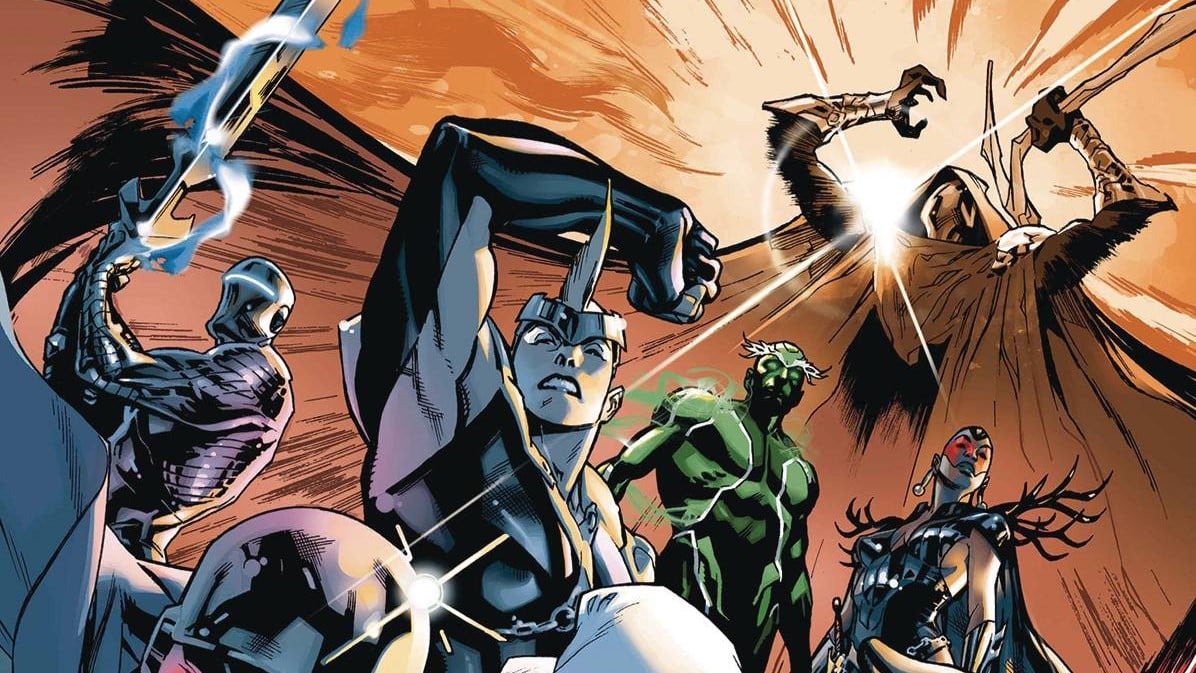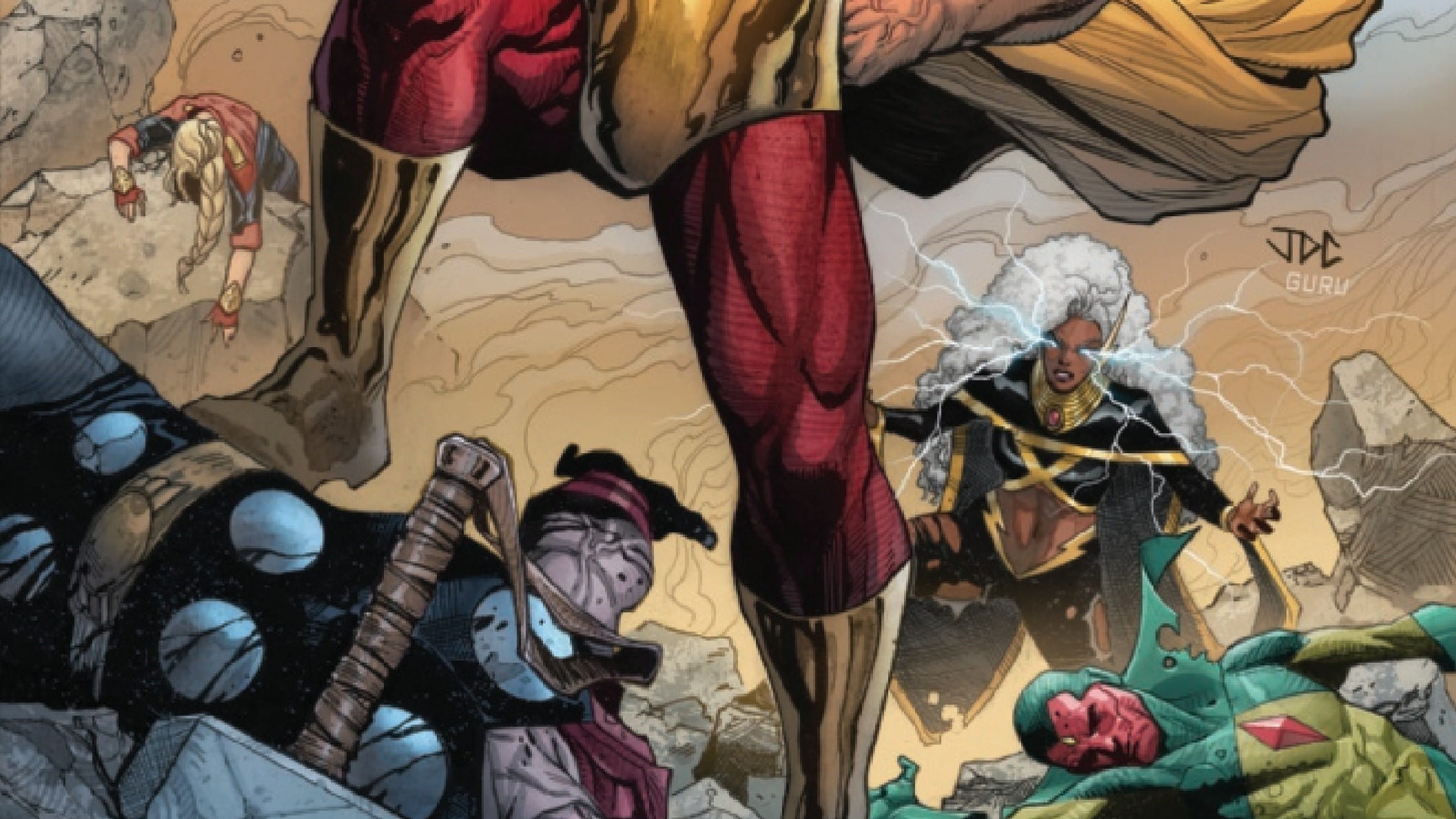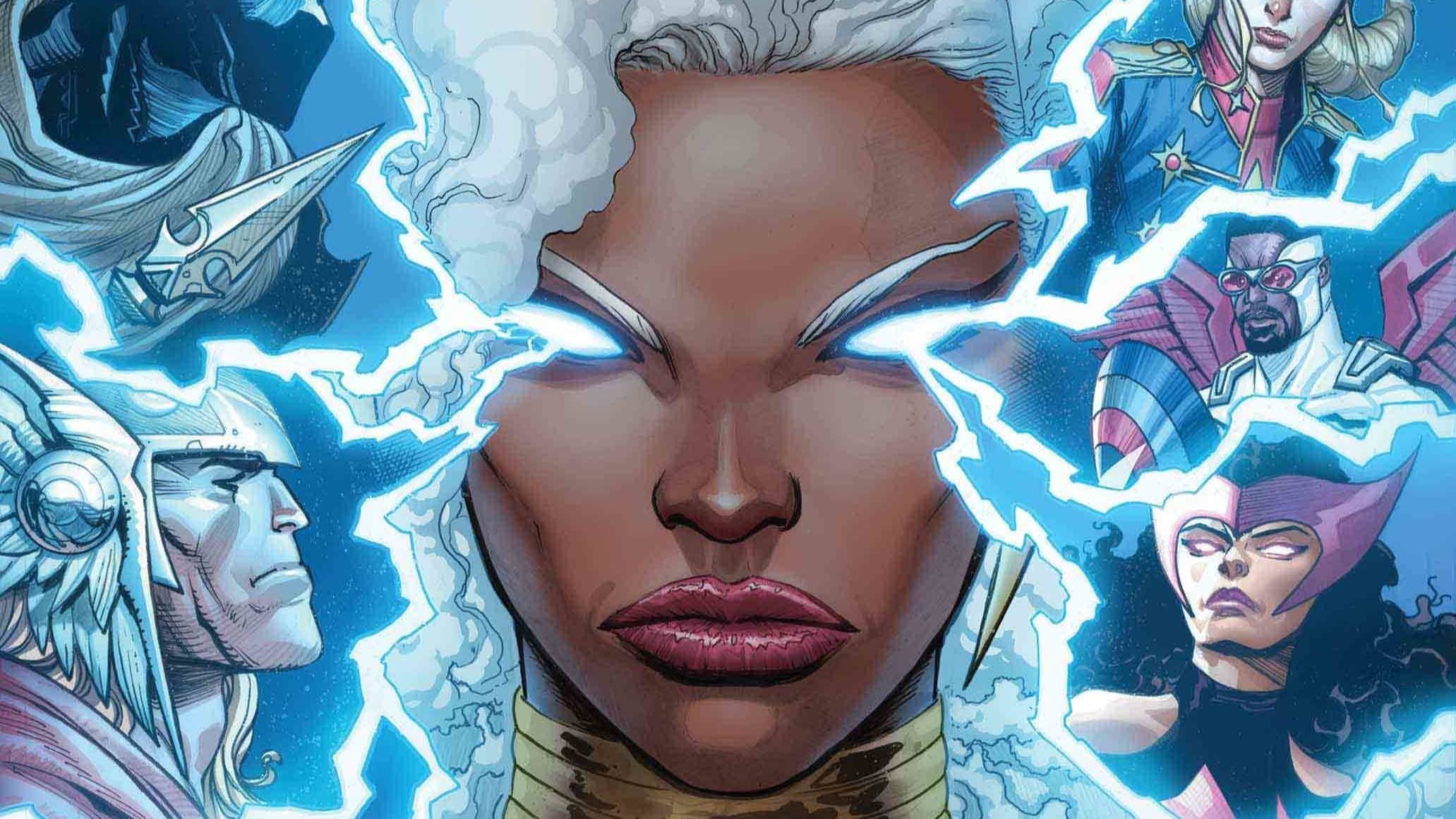The Avengers face their worst nightmares — literally, as Nightmare traps the majority of the team in a petty slumber. It couldn’t have come at a worse time, as the Twilight Court has appeared, ready to go through the Avengers just to get to Kang. Can the Vision and the Scarlet Witch hold their own until their companions wake up? Find out, in The Avengers #7 and #8, written by Jed MacKay, drawn by C.F. Villa, colored by Federico Blee, and lettered by Cory Petit.
Armaan Babu: We’ve known that bad things were coming for the Avengers for a while, but it looks like they’re finally here! Avengers #7 didn’t give us much to go on, but now we’ve got the Twilight Court and a lot more to discuss. I will say this, though—between the seven Avengers, the Five Ashen Combine, the seven of the Twilight Court and the three other major characters involved in this series so far, I’m starting to feel like there are just too many people, and not enough time for any of them to really get a moment to themselves. How about yourself?
Anna Peppard: There are so many characters! I very badly want to focus these reviews around interpersonal drama and the craft of visual storytelling, but instead, once again, I find myself spending an inordinate amount of time trying to learn the names and powersets of a brand new team of superpeople, while the main cast still hasn’t managed to purloin a page to talk about anything not directly related to doing superhero stuff.
But while there’s part of me that’s cranky about being forced to learn new things that may or may not matter in two issues, there’s part of me that wants to stop worrying and enjoy the spectacle. Because this book remains a spectacular spectacle. And I am a sucker for those, especially when said spectacles feature Vision and Wanda doing desperate team-ups in between desperate embraces. My better half wants to embrace the embraces. And I’m gonna try, or at least try to try.
Breaking Dawn

Armaan: One thing I’m struggling with, for this series, is in finding a reason I should care. The story has been so unevenly paced that I haven’t really been able to latch on to any of it. The characters have been, for the most part, having Big Moments that are satisfying to read at the end of an arc, or when they’ve been built up to—but when they’re all put in over and over again with no smaller moments to balance them out, it gets tiring.
So when nearly an entire issue gives us Big Moments at the End of the World, I find it even harder to care—especially when it’s revealed that the whole thing is just a dream.
Anna: I’ll admit, my first reaction to the end-of-the-world dream sequence that takes up most of Avengers #7 was — wait, didn’t we just do this? That disorientation was effective, to a point, but was also, as you say, exhausting in a way that may or may not be entirely productive. As drawn by Villa, everything and everyone once again looks magnificent and appropriately apocalyptic. Yet I was bored. And I don’t want to be bored.
Which is not to say there isn’t interesting stuff here. Timey-wimey shenanigans are signaled by visual twists that leave us uncertain whether we’re looking at the future or the past. Vision is sporting the pasty white look he rocked for much of the 90s. Tony Stark is wearing armor that evokes his Silver and Bronze age duds. Carol Danvers is wearing her black lightning bolt costume, which she wore in both the early 80s and early 2000s. Wanda’s costume is similarly retro, while Sam Wilson’s costume looks contemporary. We could be anywhere or anywhen.
Armaan: It’s funny — you thought it was timey-wimey stuff, I assumed we were getting a glimpse at the Avengers of another universe. Getting a glimpse of a threat that ended another Avengers team in another universe so we can feel stakes properly established. However, as a dream, the stakes are a lot less interesting.
Anna: Timey-wimey stuff can include alternate universes, right? Let’s go with that.
Armaan: I will say, this comic presents an interesting thought exercise — how do the Avengers lose? What happens when there’s no possibility of winning, and they have mere moments before the end? The theme we seem to have going in this run is that they fight on anyway. That they never give up, no matter how bad things get, but what’s interesting here is how that’s twisted.
Sure, Wanda and Sam get a cool heroic moment about the magic of iconography (and there’s something interesting to be explored in how superhero symbols might interact with magics powered by symbols), but Iron Man and Black Panther succumb to much darker sides of themselves for a last, futile blow. That line about war being Tony’s first love was especially chilling. We see Captain Marvel draining nearby stars to empower her attack — all that power, and life, drained for an empty attack.
I think there are ideas that can be explored here, particularly in the idea that the Avengers’ greatest nightmare is not just losing, but the prospect that they can give it their all and it’s still not enough — but there’s no indication that any of that is going to be explored. There’s been no talk of the lengths these heroes might go to in order to win, nor are we given any indication that this might have a lasting effect on these heroes. As soon as any of the Avengers find out they’re in a dream, they’re immediately focused on what happens next.
Like you said, though — it’s good spectacle. There’s a beautiful sense of desperation and loss here. The sunset colors of the smoke leading into the dark skies above really make this feel like we’re looking at the end (although the world ending monster itself, some kind of shorts-wearing Godzilla, feels uninspired).
Anna: I read it as an homage of sorts to famed Superman-murderer Doomsday, though I’m not sure that makes it any more deeper. Speaking of references to the Distinguished Competition, there were also a lot of lines about that end-of-the-world-or-universe threat that almost but didn’t quite say the words “anti-life equation.” Maybe it’s just a coincidence; there are only so many terms you can use to describe an apocalypse, and Jack Kirby’s operatic literal-ness takes the cake. Consider it as an observation, not a critique.
New Moon

Anna: I like to think I’m a reasonably creative person, but I also have a stubbornly literal streak. The latter informs my frequent frustration with doppelganger stories that don’t directly use said doppelgangers to offer commentaries on the characters we know and love. My favorite kind of doppelganger story uses the play of sameness and difference to teach us things about our faves we wouldn’t properly appreciate without regarding them through a funhouse mirror. But I’m not sure if this is that type of doppelganger story.
Armaan: If you’re referring to the team designations here, then I agree. Each of the Twilight Court has their own designation that mirrors the roles we’ve seen the Avengers called throughout the series. We’ve got the Star, the God, the King, and so on. To put a hat on a hat, they’re all also based on members of King Arthur’s court.
Unlike the Avengers, whose roles only come through narrative captions and recap pages, the Twilight Court are all aware of their designations, which begs the question: who is doing the designating? What are these roles, what is their purpose, and why is this particular mix necessary for a team?
One of those answers is partially clear — this team was created by a man named Myrddin, but the man’s identity remains unknown, and his only known purpose? The destruction of Kang, which puts the Twilight Court at odds with the Avengers for the moment. Shame most of them are asleep.
The last time we saw this team proper was in the Timeless special, so it’s been a while — this reintroduction to the characters as given by the Engineer was very helpful. Since we don’t quite have the space to get into every member of the team, I want to talk about the one member of this new team who caught my interest the most: the Engineer.
Designation-wise, he’s meant to be Tony Stark’s counterpart. But where Tony is overtly charismatic and subtly manipulative, there’s an (apparent) simplicity to the Engineer: he is fascinated by how people work. He understands team dynamics, is comfortable with non-interference, but could possibly pull the team along on his strings if he so wished. Instead, he’s here as support. Engineering a foundation instead of a flying suit. He’s the Engineer I imagine people wish Tony could be.
The other team members, though…it’s hard to see whether or not they have any comparable traits to their counterparts that I can see. Who’s caught your eye from this team, Anna?
Anna: I perked up at the tragic unrequited love of King Artur (whose designation suggests he should be the Black Panther stand-in) for Parsifal (who should be the Captain America stand-in). The scene that introduces this tragic love does a lovely little queer twist, where you might assume (because of our society’s ongoing rampant homophobia) that the love is forbidden because it involves a male-presenting character loving another male-presenting character. But that’s not the reason.
Instead, the love is forbidden and tragic for reasons of duty and disability, with Artur’s body being seemingly entombed inside his mystic armor. If you’re not in a charitable mood, maybe it’s a case of having your cake and eating it too; the gay guy doesn’t get to kiss a guy because he can’t kiss anyone, so we get representation, but in name-only. But I liked it; these characters are concerned with things much bigger and grander than petty gender roles, and so should we be.
Part of what makes me sympathetic to the representation on offer here is the fact the entire team has some delightful queer vibes. Some character designs are gender ambiguous, some of the names are gender-flipped (Lancelot is female-presenting), and there are some fun vibes between the aforementioned Lancelot (the Carol stand-in), with her slim, agile body, and the also female-presenting but considerably bigger and thicker Galehaut (the Thor stand-in).
That said — I’m not sure if I should be more invested in the interpersonal dynamics of these characters I just met than any of the interpersonal dynamics of our regular cast. Interesting antagonists are great, but the fact I found the Twilight Court more interesting in just a few pages than I’ve found most of the Avengers for most of this book feels telling. And like I said above — I wish the interpersonal dynamics within the Twilight Court felt like commentary on the main cast. I’d read a story where T’Challa harbored unrequited love for Sam Wilson, but I don’t think that’s being suggested here. The Twilight Court are funhouse mirror reflections without stable referents.
Eclipse

Anna: I know this section heading doesn’t quite work. But never let it be said I’m not willing to sacrifice intelligibility for the sake of a bit. Anyway…
Nightmare is one of those deus ex machina villains. He’s often used to give artists and writers an excuse to write and draw a bunch of crazy crap that doesn’t need to make sense because it’s a nightmare and those never make sense, anyway. The story metatextually acknowledges the diminishing returns of this character, which have been an issue for decades, by having Nightmare reference past humiliations by the likes of Jean Grey, about which he’s supposedly still bitter. But honestly, he could have said virtually any character in the Marvel Universe. Who hasn’t humiliated Nightmare? Marvel heroes call that a Tuesday.
Still, the story does try to preserve Nightmare’s menace by hinting at grander purposes beyond his possibly momentary childish hubris. While I appreciated that (and strongly appreciated Villa’s character design), the whole encounter can’t help but feel a bit like treading water. Given the pacing issues this book has had, it seems counterintuitive to slow things down yet again with a dreamscape sojourn that arguably doesn’t actually teach us all that much about our casts’ subconscious fears.
Armaan: There are two things I don’t quite buy into here, with the Nightmare storyline.
I fully believe that he would be petty enough to trap the Avengers in a bad dream just so he can finally win at something. What I don’t believe is that he’d choose to just forget the Avengers when Thor is openly laughing at him regarding the pettiness of the request — when his admission of surrender is so blatantly hollow.
The bigger thing I can’t buy into is the idea that this story beat means anything. It’s clearly meant to be another Big Moment — the God, setting aside his pride to save the day. But when the stakes are so empty, it hardly feels like Thor’s really setting aside anything. In fact, it makes the other Avengers feel pretty stubborn, and not in a good way, that they wouldn’t just say something along the lines of “Fine, fine, you win, can you wake us up now so we can save our friends?”
Anna: The Thor moment was annoying, but I want to be clear about why. I get what it’s doing. MacKay is showing us that this team is a team in the truest sense of the word because everyone has different strengths that might allow any of them to take the lead in certain moments, even if Captain Marvel is still the ultimate leader. But that hasn’t been a throughline of the book. This is the first time we’re seeing this dynamic, which contributes to it seeming out of place.
Which informs the other thing that annoys me about it. For the past couple of weeks, my colleague Andrew Deman and I have been writing threads about the history of Carol Danvers for our academic social media project Sequential Scholars. In conversation with that, and a recent uptick in Comics Gate activity inflamed by Mark Millar (among others), I’ve been exposed to a lot of fanboy misogyny lately, much of it specifically involving the character of Carol Danvers (one lovely gentleman provided a very detailed description of his pitch to “fix” this supposedly “bitter, man-hating” character, which included her being serially sexually assaulted). And I definitely saw a couple of these CG-style accounts tweeting the panel where Thor takes the lead with captions like “finally, a man puts Carol in her place” (but I’m using nicer language than they did).
I don’t think for a second that was MacKay’s intention for the scene. But it’s a perfect illustration of how frustrating writing and interpreting comics can be. Here I am complaining that the scene is too didactic. But apparently, for some readers, it wasn’t didactic enough. There’s no easy fix for any of that. Still, making Thor momentarily take the lead less of an unexpected, isolated moment could have helped a little.
Armaan: While the rest of the Avengers are negotiating their way out of a bad dream, we see Wanda and the Vision holding their own pretty handily against the Twilight Court. It’s great to see them holding back a team meant to take out the entire Avengers team, but the scene left me a little wanting. The Vision and the Scarlet Witch have a long history that I know we both have a fondness for, Anna — but there’s no real indication of that history existing here. Someone picking this comic up for the first time would assume little more than that these two are work colleagues. Given the circumstances, that’s reasonable – they’re focused on the fight, of course. But it feels like a missed opportunity.
Anna: I’ll confess to being a little confused about what’s going on with Wanda and Vision lately, and wonder if there’s some editorial mandate somewhere getting in the way of some things. In recent years, there have been quite a few isolated moments and cover images showing the characters paired with each other in dramatic moments and even embracing, but as of this writing, we haven’t seen them having any actual, substantial conversations about their past or potential future, as friends, lovers, parents, or whatever else they may or may not want to be to each other. It feels like promotional imagery wants to trade on the legacy of these characters while the stories themselves want to keep things nebulous, for reasons. Which can lead to some weirdly shallow narrative beats.
Armaan: For most of the fight, the one person who holds himself back is Parsifal, whose powers work a little like Longshot’s — everything goes his way as long as his cause is just. A whole team vs. two Avengers is far from just, but when the rest of the team finally wakes up to resume the fight?
Now things get interesting.
Or so we hope.
Avengers Assortments
- Thor implies Nightmare may have had other motivations beyond pettiness for trapping the Avengers… and the timing is suspect. Are he and Myrddin working together?
- Galehaut is the God, but the God of what? Unclear, although her mohawk does look similar to a certain God of War’s…
- The Twilight Court apparently have their own Tarot cards that bear little resemblance to traditional Tarot — and are apparently a lot more literal!
- Is Myrddin a version of Merlin? If so–which one? [Ed. Note: my vote is for the one who gets defeated by being wrapped up in a curtain.]







